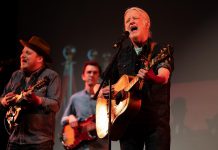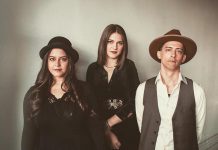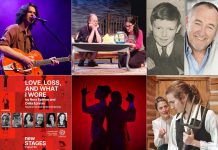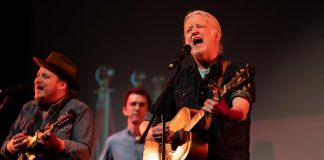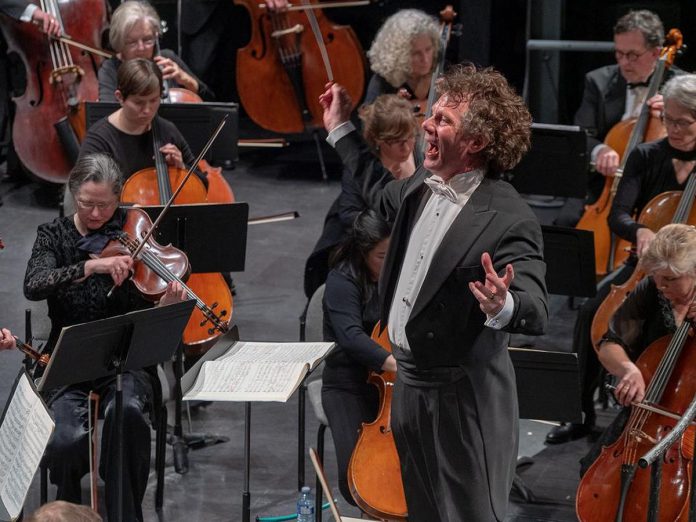
The Peterborough Symphony Orchestra is wrapping up its 2022-23 season on Saturday, May 27th at Showplace Performance Centre with “Welcome to the Dance”, a fun and fiery mix of jazz, Latin, and classical sounds along with spoken-word performances by special guest artist Sarah Lewis from Curve Lake First Nation.
Presented by sponsor Euphoria Wellness Spa, the evening’s program includes Russian composer Igor Stravinsky’s The Firebird Suite, American composer Florence Price’s Dances in the Canebrakes, Mexican composer Arturo Marquez’s Danzón No. 2, and American composer Leonard Bernstein’s Symphonic Dances from West Side Story.
Welcoming audiences back to the Peterborough Symphony Orchestra has been a recurring theme of all of the concerts this season, the first since the pandemic began where the orchestra is performing a full slate of five in-person concerts.
In fact, the idea for “Welcome to the Dance” came from a program the orchestra had originally planned for its pandemic-cancelled April 2022 concert. According to music director and conductor Michael Newnham, that concert was to be called “Jazz Goes to the Symphony” and would have included both Bernstein’s Symphonic Dances from West Side Story and Price’s Dances in the Canebrakes, among other pieces.
Newnham says the season finale concert is called “Welcome to the Dance” because the program consists of music that was either inspired by movement or meant to be danced to.
“A lot of this music also has to do with social change,” Newnham tells kawarthaNOW. “Because of Sarah Lewis’ strong style and pride in her Anishnaabe Kwe heritage found in her poetry, and because of the fact that she was the inaugural poet laureate of our city, we have invited her as guest artist to add the spoken word in between some of the music to be presented.”
VIDEO: “Warrior Cry” – Sarah Lewis
Igor Stravinsky
Born in Russia and later living in France and then the U.S., Igor Stravinsky was a composer, conductor, and pianist who is widely considered one of the most important and influential composers of the 20th century and a pivotal figure in modernist music for his approach to rhythm. Composed in 1910, The Firebird was the first of three ballets that Stravinsky — who was a young and virtually unknown composer at the time — was commissioned to write by Russian impresario Sergei Diaghilev, who had just formed the Ballets Russes company in Paris.
Based on Russian fairy tales of the Firebird, a magical and prophetic glowing or burning bird from a faraway land which is both a blessing and a harbinger of doom to its captor, the ballet was an immediate success and catapulted Stravinsky to international fame. Although it was originally designed as a ballet for the stage, with certain passages accompanying characters and action, the music has since gained much recognition as an orchestral piece. Younger people will recognize The Firebird Suite as the last of eight classical works to appear in the 1999 Disney film Fantasia 2000.
“It forever changed the way symphonic music was written and perceived,” Newnham says. “Stravinsky emphasized unusual rhythms and note patterns, while keeping a strong link in his music to the Russian folk idiom.”
VIDEO: The Firebird Suite – Igor Stravinsky
Florence Price
American composer, pianist, organist, and music teacher Florence Price was born in Little Rock, Arkansas in 1887, and is the first African-American woman to be recognized as a symphonic composer and the first to have a composition played by a major orchestra. At the age of 15, she enrolled in the New England Conservatory of Music in Boston, Massachusetts, and eventually moved back to Little Rock after marrying a lawyer who had his practice there.
Unable to find work in the by-then racially segregated Little Rock and, after a series of racial incidents including a lynching, she and her husband and their two daughters moved north to Chicago, where her career as a composer flourished. Before her death from a stroke at the age of 66, Price had composed over 300 works, including four symphonies, four concertos, choral works, art songs, chamber music, and music for solo instruments. She frequently used the music of the African-American church, including spirituals, and material for her arrangements.
“She infuses her style with the atmospheres of her childhood in Little Rock,” Newnham explains. “You can hear the strong influence of Black music in almost everything that she writes. Her Dances in the Canebrakes was one of the last piece she composed before her untimely death, and it feels fresh, free, and untroubled.”
VIDEO: “Dances in the Canebrakes” – Florence Price
Arturo Márquez
Born in Alamos, Mexico in 1950, award-winning composer Arturo Márquez was introduced to music by his mariachi musician father and folk musician grandfather. When Márquez was 11, his family moved to Los Angeles where he played the violin in school. He began composing at the age of 16 and attended the Mexican Music Conservatory to study composition. He later studied music in Paris before returning to California. He began to frequent Mexico City’s dance halls, where he discovered the danzón.
The official musical genre and dance of Cuba, the danzón also became very popular in the Mexican Gulf Coast state of Veracruz, because of the strong Cuban influence in the region, and later in Mexico City. Márquez’s Danzón No. 2 was commissioned by the National Autonomous University of Mexico and premiered in 1994 in Mexico City. According to Márquez, the music was inspired by a visit to a ballroom in Veracruz. Written for full orchestra, the piece features solos for clarinet, oboe, piano, violin, double bass, French horn, trumpet, flute, and piccolo.
“Marquez wrote many danzóns, but his most popular by far is No. 2,” Newnham says. “It combines tenderness, wistfulness, and the unbridled frenetic energy of Latin-American music that we love so much. I chose to include it in this concert because of some similarities it has with the music to West Side Story.”
Leonard Bernstein
American composer Leonard Bernstein is considered to be one of the most important conductors of his time. He was also a pianist, music educator, author, and lifelong humanitarian who worked in support of civil rights among many other causes. As a composer he wrote in many genres, including symphonic and orchestral music, ballet, film and theatre music, choral works, opera, chamber music, and works for the piano.
Bernstein’s score for West Side Story is his best-known work. With lyrics by Stephen Sondheim, the musical debuted on Broadway in 1957 to critical acclaim and ran for 732 performances before going on tour. Nominated for six Tony awards and winning two, it continues to be regularly performed worldwide and has been adapted into two feature films.
“The influence of jazz and Latin music on Leonard Bernstein’s score is unmistakable,” Newnham notes. “His genius for bringing all the elements of popular music and combining it with the most rigorous classical forms, like the fugue, is spellbinding. This music has been a big part of my life since the first time I heard and fell in love with it at the age of 10. There is a reason why this score is so popular. It’s just great music that transcends all boundaries.”
VIDEO: “Mambo” from Symphonic Dances from West Side Story – Leonard Bernstein
The Peterborough Symphony Orchestra’s season finale concert promises to be as exciting for the orchestra’s musicians as for the audience, according to Newnham.
“The musicians keep telling me how much they are looking forward to this concert,” he says. “We’ve been waiting for our chance to do it for over three years now, and we can’t wait.”
“Welcome to the Dance” begins at 7:30 p.m. on Saturday, May 27th at Showplace Performance Centre at 290 George Street North in downtown Peterborough. A pre-concert “Meet the Maestro” talk takes place at 6:45 p.m., where Newnham takes the Showplace stage for an intimate chat about the evening’s program.
All audience members are also invited to a post-concert reception downstairs in the Nexicom Studio, sponsored by Cork and Bean, to meet Maestro Newnham and members of the orchestra.
Single tickets are $33, $48, or $55, depending on the seat you choose, with student tickets costing $12 for all seats. Tickets are available in person at the Showplace Box Office from 10 a.m. to 4 p.m. Monday to Thursday, 10 a.m. to 2 p.m. Friday, and one hour before the concert, or online anytime at showplace.org. Student tickets are only available online.
New this season is a “rush ticket” option, where seats are available on the day of the concert for only $20 (online only, depending on availability).
kawarthaNOW is proud to be a media sponsor of the Peterborough Symphony Orchestra’s 2022-23 season.


